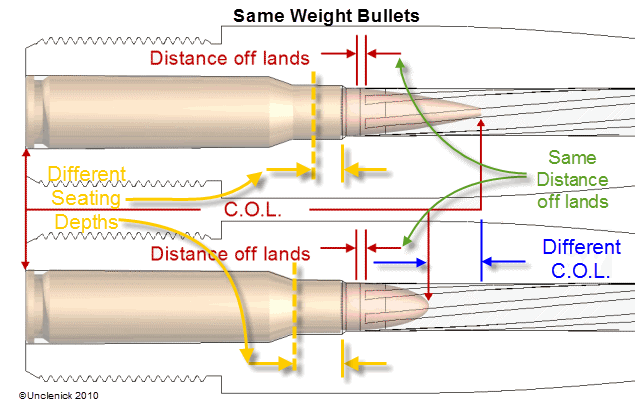Stats Shooter
New member
Have you tried a load workup to see what the actual results are? If not, maybe Hornady is wrong.
I just measured a cleaned resized case trimmed to 2.620" with a new Winchester large rifle magnum primer full of distilled water - it held 91.3 grains of H20.
By the way, you are assuming I was concerned more with what my actual load produced in my rifle. I was far more concerned with the difference of the projected load by QL and the Hornady load data.
HoustonBob said:I just measured a cleaned resized case trimmed to 2.620" with a new Winchester large rifle magnum primer full of distilled water - it held 91.3 grains of H20.
.
.
Hornady: 25" barrel Hornady brass Winchester WLRM primer 110 VMAX 69.0 grains of Varget COL 3.300" 3700 fps. Max Load for Hornady.
Why? Your logic that the same pressure will result from two different chambers is the thing. I have one rifle that has a tight chamber and the body of it's brass hardly grows at all when I shoot it. Then I have another rifle that the case volume is increased by 6 full grains of powder from a "cleaned resized case"
Also, as I mentioned above, testing over a chronograph would be useful in determining who is closer to your velocities. However I am betting it is Quickload. I have hornady manuals, Lyman, Sierra, nosler, Speer, Barnes, and use Hodgdon's website. I have found Lyman to be the closest to what I am able to achieve, but not as close as Quickload who is usually within 1% or less.
So, the reason behind measuring the FIRED brass capacity is that is what is important in YOUR rifle. You are never going to be able to replicate the Hornady loads from the manual 100% UNLESS you have the exact same lot of brass, powder, primers, bullets, and importantly the same gun that Hornady used to work up the data. And by that I mean literally THE gun Hornady used.
Curious as to why you use the resized case volume while the QL manual says to use fired case volume, not resized, for cartridges with peak pressures over 30,000 psi.
Curious as to why you use the resized case volume while the QL manual says to use fired case volume, not resized, for cartridges with peak pressures over 30,000 psi.
I have chronographed my loads with heavy bullets on my Remington 700 Long Range (26" Barrel) they are very close to both Quickload and the Hornady manual - both of which pretty much agree. What started this whole thread was when I used a Chronograph on my load with 110 grain bullets (I was looking for an accuracy node that my alpha level resonance software predicted would exist) and the chronographed results were in line with the Hornady manual (25" barrel) and not close to the Quickload data. That is why I think Hornady is correct and Quickload is throwing spurious results with 110 grain bullets.
It is difficult for me to see why heavy bullets give chronograph readings in line with both Hornady and Quickload, then give readings in line with Hornady with 110 grain bullets - but not in line with Quickload - and somehow the problem lies with my rifle and Hornady, and not with Quickload.
Dessiminator's point here is amplified in the .300wm. The .300wm is unique in how much a factory, unfired, case grows in the first firing. Using my case gauge, I measure Norma Brass from casehead to datum to be 2.55". Upon firing, that same measurement is 2.700-2.7005". So almost 0.15" growth, and that's in my tight chambered competition gun. In some rifles with different brands of brass, when headspaced off the belt as factory new, the may grow up to 0.20" from casehead to Datum....
don't see how it is possible the brass "grows" over the rifle's headspace.

